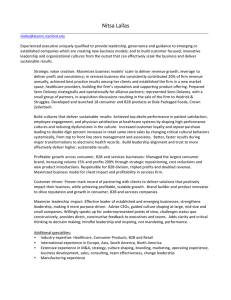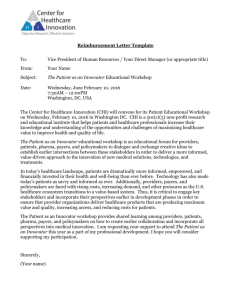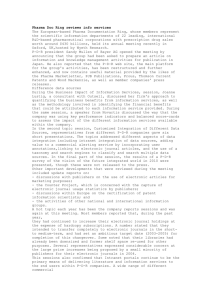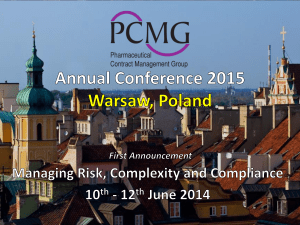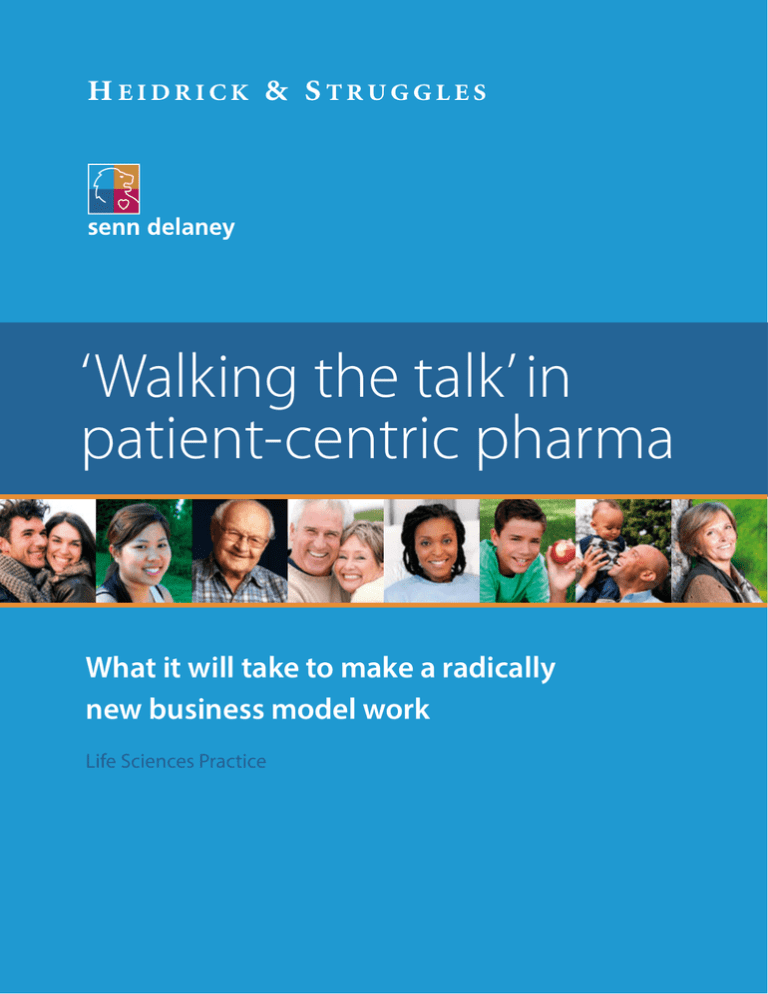
‘Walking the talk’ in
patient-centric pharma
What it will take to make a radically
new business model work
Life Sciences Practice
‘Walking the talk’
in patient-centric pharma
What it will take to make
a radically new business
model work
As governments, payers, and healthcare
providers rapidly move toward a health
system that focuses on outcomes rather
Today’s increasing emphasis on patient outcomes is
being driven by a confluence of powerful forces: Aging
populations and increases in chronic diseases have put
new strains on healthcare systems. Policy makers and
payers seek to control costs by requiring evidence of value
and comparative effectiveness, compelling healthcare
providers to focus on patient impact. At the same time,
the technology-driven ability to leverage health data is
enabling providers to make better and faster diagnoses as
well as more informed treatment decisions. Consumers,
than products and services, pharmaceutical
too, are playing a major role in this revolution. They now
companies are feeling their way toward
arrive in physicians’ offices armed with information, and
a new business model: patient-centricity.
treatment is transforming healthcare from a provider-
their insistence on taking a more active role in their
This shift of emphasis from products to
dominated marketplace to a consumer-centered system.
patients represents a radical departure for the
To provide the kind of value increasingly being required
pharma industry, upending a half-centuryold business model based on blockbuster
drugs, incremental innovation, and
physician preferences.
Continuing pressure on the old model and
the business benefits of adopting the new
model will accelerate the drive toward
by governments, payers, and patients, pharmaceutical
companies will need to genuinely commit to putting the
patient at the center. “Patient-centric” cannot simply be a
marketing buzzword. Pharma companies must walk the
talk – or else risk reputational damage.
Nor should patient-centricity be confused with patient
engagement and its emphasis on patient compliance.
Genuine patient-centricity means understanding the
patient’s experience of his or her condition – what the
individual patient values and needs and what is most
likely to result in a positive healthcare outcome in that
patient-centricity, but new strategies and new
context. The insights gained by listening to the voice of
organizational structures will not be enough.
the patient can be applied at every stage of a pharma
Top leaders will not only have to develop
regulatory approval to post-market disease management.
company’s efforts, from drug discovery to winning
innovative patient-centered models, they will
As a result, the company will be able to bring drugs to
also need to achieve enterprise-wide culture
reimbursement and price, as well as prescribed volume
change and introduce the new leadership
competencies patient-centricity requires.
2 ‘Walking the talk’ in patient-centric pharma
market that better reflect patient needs (and may increase
for precisely that reason), better align with the reward-foroutcomes that governments and payers insist upon, and
help patients and providers achieve better outcomes.
Making the transition will be far from easy, requiring
concurrent changes in strategy, structure, and culture. Of
these three, culture change is likely to present the greatest
challenge to pharmaceutical companies. In the absence of
culture change, new strategies and structures are unlikely
to achieve the transformation at the requisite speed.
Further, the shift from a product-driven approach to a
patient-centric approach requires deep and lasting change
in the habits, attitudes, beliefs, values and all of the other
assumptions that collectively add up to “the way we do
things around here.” Because pharma’s traditional business
model has been successful for decades and in place for so
“There is a real desire within
industry to do what is in the
best interests of patients,
by shifting the relationship
away from the historically
‘paternalistic’ focus on patient
education and compliance.”
long, the culture associated with it is deeply entrenched
and particularly resistant to such sweeping change.
Moreover, cultural transformation must be pursued on
three levels concurrently: the personal, the team, and the
organizational. It is a daunting challenge. To meet that
cultural challenge, companies can start by taking care to
do these three things as they develop patient-centered
strategies and the requisite organizational structures:
•
Build culture change into business
model innovation.
•
•
Lead culture change from the top.
Understand the competencies required of
patient-centric leaders.
By adhering to these principles a company can achieve
the culture change that is essential for success, not
only enabling the entire organization to walk the talk
of patient-centricity but equipping it to do so for the
long term.
Heidrick & Struggles | Senn Delaney 3
Lode Dewulf, MD
Chief Patient Affairs Officer, UCB
Building culture
change into business
model innovation
A number of pharmaceutical companies have taken
to bear in cooperation with caregivers to add value in
tentative steps toward patient-centricity. A few have made
previously unimagined ways. In fact, the global healthcare
great strides. Denmark-based LEO Pharma operates in
system in 2012 saw some $7B in health IT investment.
more than 100 countries and focuses on dermatologic
Further, pharma companies will need to partner with
and thrombotic conditions. LEO is hastening its
newcomers in the healthcare market, such as IT, food and
transformation to patient-centricity by experimenting
technology companies.
and testing multiple new business models across the
organization in such areas as patient services, payer
New reward structures
engagement, pharmacy engagement, and more. The
As the criterion of success becomes optimal patient
aim is to leverage the company’s understanding of
outcomes, pharma companies will need to forge workable
patients and engage them to “co-create” care solutions
reward structures for their role in achieving those results.
and future business models. Similarly, UCB, the Belgiumbased multinational specializing in treatment for severe
disorders of the immune and central nervous systems,
has put patient-centricity at the heart of its values and
has appointed a Chief Patient Affairs Officer to accelerate
the transformation.
Those common themes suggest dramatically different
ways of doing things – whatever the specifics of a
particular patient-centric business model. The company
will need to build new capabilities, change customerfacing roles, and alter the structure of the organization.
These changes in strategy and structure, if they are to
New business models, with their accompanying value
succeed and to be sustainable, must be accompanied by
propositions, organizational structures, and profit formulas
culture change – a conscious, enterprise-wide effort to
will of course differ from company to company – there
instill a shared focus on the patient.
is no one-size-fits-all. However, the changing healthcare
landscape does suggest that new business models will
have to accommodate some common themes.
A shift from brand to disease
Payers, providers, and patients focus on disease areas, not
brands. Pharma companies of course often specialize in
one or more therapeutic areas, but scientific concentration
on branded drugs for such areas is a much narrower
focus than holistic treatment of a condition, especially if it
is chronic.
Further, the ultimate intent of a new business model is
to disrupt and eventually supplant the existing business
model. As Clayton Christensen, author of The Innovator’s
Dilemma and other groundbreaking work on “disruptive
innovation,” has observed, such transformations are
particularly difficult for large, well established companies.
As a company makes the transition to the new model, it
must continue to execute on the existing product-based
model, allocating resources for both efforts simultaneously
and gradually shifting the center of gravity over time.
Often, however, the new model is overwhelmed by the
New partnerships
sheer cultural inertia of the old ways of doing things,
To be a valuable part of the holistic delivery of treatment,
yet produced tangible financial results. Culture change
pharma companies will have to find new ways of
can happen by design or by default – and the default will
collaborating with payers, providers, and patients. For
usually be to the old culture, resulting in a failure to deliver
example, the wealth of data that pharma companies
on the new value proposition and subversion of the new
accumulate about patient populations could be brought
organizational structure.
4 ‘Walking the talk’ in patient-centric pharma
especially in the early days when the new model has not
Driving culture
change from the top
CEO
Chief
Experience
Officer
The change starts from the top, with the CEO assuming
the role of a de facto ‘Chief Experience Officer’ to drive
innovation and transformation, while continuing to
Culture
execute on current business imperatives and preserving
what is relevant from the existing business model. To keep
the balance from tipping back in favor of the existing
P-SUITE
model, the CEO can organize patient-centric leadership
to drive the agenda through the entire value chain,
transcending traditional boundaries of R&D, Regulatory
Patient
Centric
Leaders
Affairs, Sales & Marketing, and Payer and Provider and
enlarging the outlook of the people within those old
boundaries. For example, given the broader definition
of stakeholders to include patients, providers, payers,
and governments, Sales & Marketing will need to how it
Process
& Ideas
allocates its resources, targets “customers,” and incents its
personnel. Similarly, R&D will need to think beyond the
molecule to the vastly greater possibilities that a patientcentric approach opens up.
TRADITIONAL
FUNCTIONS
Patient-centric leadership could consist of a Chief Patient
Officer (CPO) or the like, or a group of leaders – a kind
of “P-suite” to stand outside of the commercial function
and drive culture change by sending a unified message
R&D
on behalf of the patient/consumer rather than a diluted
Regulatory
Medical
Affairs
Market
Access
and conflicted message restricted by capabilities, domain
Innovation
and capital (fig 1). But regardless of how this leadership
is structured, it will need to do four things if it is to
successfully create a culture that enables new strategic,
operating, and organizational models to flourish:
•
Provide purposeful leadership that models
the culture from the top down.
•
Unmet
Needs
Patient
Insight
Patient
Change the collective culture by creating
genuine individual change.
•
Build pace, momentum, and engagement
across the whole organization.
•
Ensure sustainability of the new culture by aligning
practices and policies with the desired change.
figure 1
Patient-centric leadership
Heidrick & Struggles | Senn Delaney 5
First, people watch what their leaders do and emulate
Third, unless the organization can achieve a brisk pace,
them. Individually and collectively, leaders, through all
build momentum for change, and keep all employees
of their actions, become role models for change – or not.
engaged, it will remain stuck in its old ways or revert to
And that includes not just the leaders in the C-suite or the
them when the effort wanes. Everyone, enterprise-wide,
“P-suite” but the top leaders throughout the organization.
must be continually engaged in a way that helps them
If the leaders do not personally own the change, nobody
shift their personal assumptions and align to a new way
will. Further, employees are increasingly motivated by the
forward in terms of behavior, action, and results.
mission of the companies for which they work. Leaders
who genuinely live the credo of patient-centricity can
significantly increase employee engagement, which is
widely known to drive productivity.
Fourth, to sustain change and create a culture that
traverses all of the institution’s boundaries, you must align
many factors: institutional practices, systems, performance
drivers, communications, and capabilities needed to drive
Second, culture in its essence is composed of individuals
towards the desired culture. Governance structures will
and their fundamental assumptions and beliefs. If a new
need changing, as will decision-making processes. The
culture is to take deep root and endure, each of those
same is true for daily rituals, such as meetings, team-
individuals – from the leader through all levels of the
based decision-making, and measurement. Further, the
organization – must embrace it. Genuine and lasting
organization should examine customer/consumer and
personal change occurs only when people powerfully
supplier/partner touchpoints and, if necessary, adapt them
experience different ways of doing things and succeed
to make the change real.
at them. In our work on culture change with leading
companies, we have found that the most effective way to
make a lasting impression on individuals about the value
of the desired personal changes is by providing them
with insights as to why the change is beneficial. Through
focused engagement and personal and team coaching,
individuals who have been driven by narrow customerfocused goals and metrics can personally experience
The degree to which each of these four principles is put
into practice determines the degree to which the effort
will succeed. Omit any one of them – or apply them halfheartedly – and frustration and reversion to the old ways
are likely to follow. Get them right and the conditions for a
newly competitive, genuinely patient-centric organization
can emerge.
the more holistic perspective that patient-centricity
requires. Unless change occurs at this deep and individual
level, the new business model is unlikely to take root in
the organization.
“…culture in its essence is composed of individuals and their
fundamental assumptions and beliefs. If a new culture is to
take deep root and endure, each of those individuals – from the
leader through all levels of the organization – must embrace it.”
6 ‘Walking the talk’ in patient-centric pharma
CASE STUDY: UCB
Parkinson’s Disease
More than shaking
In 1817 an English doctor, James Parkinson,
published his essay reporting six cases
of paralysis agitans. His “Essay on the
Shaking Palsy” described the characteristic
resting tremor, abnormal posture and gait,
paralysis and diminished muscle strength,
and the way that the disease, which was
later named after him, progresses over
time.
Thus, the insights gained from our deep listening to
Almost two centuries later, most people, including those
this resulted in the development and validation of the
working in health care still think of Parkinson’s Disease
Parkinson’s Well-Being Map™ a patient-centric and patient
as primarily affecting the motor system, with shaking
friendly self-assessment tool.
and disturbed movement being the main issues. For
The tool is available for free on-line and can be used in
clinicians this conclusion is rather logical, since the
both paper and electronic format. It helps enable a much
motor disturbances are what really stand out during the
better and more helpful discussion between patient and
brief and infrequent doctor visits. No wonder thus that
physician and also to track the fluctuating disease as well
(improvement of ) motor symptoms have been the (only)
as the effect of different therapeutic options.
patients revealed an important gap in the current
understanding, assessment and management of
Parkinson’s Disease (PD). We clearly needed a disruptive
intervention to raise general awareness of and attention
for the non-motor dimension of the disease.
Over the following (many) months, UCB continued to
work with many patients to develop an easy assessment
tool aimed at more adequately describing how someone
living with PD is actually doing at a given moment in
time. With the help of many patients and in partnership
with the European Parkinson’s Disease Association (EPDA)
standard used and reported in clinical studies and thus
also for the development and approval of new medicines.
www.epda.eu.com/en/parkinsons/
But when UCB started to listen much more deeply to
life-with-parkinsons/part-3/
the stories that are told by people actually living with
the-parkinsons-well-being-map
Parkinson’s (and this includes both those having the
disease as well as those caring for and living with the
The tool has become a frequently used and well
patient) a common theme soon emerged: the motor
respected aid in the management of Parkinson’s Disease.
symptoms of Parkinson’s are not the hardest part of living
Importantly, the tool is also changing the perception
with the disease. Direct observations throughout the day
of the disease itself by all stakeholders (patients, carers,
and night of people living with Parkinson’s confirmed that
researchers, regulators, payers), and this opens up new
not only are there many non-motor symptoms, but these
avenues for assessing and developing improved therapies.
are both frequent and important. Unfortunately, these
As such, this tool, built upon patient insights provides a
non-motor symptoms were seldom discussed, let alone
new solution to help improve the lives of people living
measured, during routine clinical care, and they seemed
with Parkinson’s Disease.
to play little to no role in therapeutic and regulatory
decision making.
Heidrick & Struggles | Senn Delaney 7
Understanding the
competencies required
of patient-centric leaders
The patient-centric leadership structure may vary
depending on the organization. In some cases, the
CEO may be the principal driver of the effort. In other
companies, the best solution may lie in the appointment
of a Chief Patient Officer – a single top executive charged
with promoting and developing patient-centricity. Other
organizations may create “P-suite” that seeks to make a
difference in the way things are done in each function. Still
Driving Decision-Making
Recognizing that success requires recognizing how
decision-making has changed in healthcare, and who is
making those decisions, patient-centric leaders will see
that patient well-being drives internal decision-making
as well.
other organizations make expect patient-centricity part of
Monitoring Execution
the requirements for any leadership role. But regardless of
Leaders will keep the key performance indicators of a
the title these patient-centric leaders wear, they will need
positive, compassionate patient experience front and
some specific competencies in five critical areas (fig 2).
center in monitoring and measuring execution and
make sure that “soft” data isn’t crowded out by narrow
Relating to External Stakeholders
Patients constitute the largest group of those external
stakeholders. Leaders must understand how patients see
the company and carefully consider how the company
interacts with them. Most importantly, patient-centric
leaders must fully understand patient needs and be able
to articulate those needs clearly and persuasively to the
organization and be able to form partnerships with payers
financial criteria. To continually improve execution, they
will dedicate and develop resources – from analysts
that look specifically at satisfaction and experience data
trends to social media experts who can help enhance the
patient experience. Meanwhile, in-depth analysis of the
economics of patient loyalty will enable everyone in the
organization to understand the payoffs that investments
in patient-centricity generate.
and care providers to drive better patient outcomes.
Facilitating Culture Change
Strategic thinking
As change agents for patient-centricity, leaders should
Though patient-centric leaders might not be their
companies’ chief strategists, they should be able to refine
development and commercialization strategies in ways
that deliver greater demonstrable value to patients.
They will invest in understanding customers and their
preferences, desires, and cultural attitudes in order to
help design tailored products, services, and education
strategies that genuinely differentiate the company from
competitors. And they will continually make the patient’s
experience a part of ongoing business reviews and
strategy discussions.
8 ‘Walking the talk’ in patient-centric pharma
be able to help diagnose the current culture and define
a direction to a new one that is infused with a passion
for patient care. They must be adept at breaking down
organizational silos that are barriers to patient care –
especially where people are clear about their own roles
but not about overlapping and ambiguous territories. And
they must be able to help other leaders infuse the patient
perspective in their teams.
figure 2
Evaluating for Patient-Centric Leaders
LEADERSHIP ATTRIBUTES FOR
PATIENT-CENTRIC LEADERS
CRITICAL
COMPETENCIES
Facilitating
culture
change
Relating
to external
stakeholders
Business Skills / Knowledge
•
Develops a compelling
patient engagement and
advocacy vision and strategy
•
Demonstrates a clear
understanding of marketplace dynamics and how
broad trends shape the future
•
•
In-depth understanding of
entire healthcare value chain.
and divisions, commercial as
well as scientific
•
Works to translate patient
priorities into specific
deliverables
Diversity of experience across
grass-root healthcare
+
Personal Attributes
Strategic
thinking
Driving
decision
making
•
•
•
•
•
Intelligent – smart, quick
and analytical
Resilient, persistent
•
Facilitates change
/ ideas / creativity
•
•
Can lead from front and back
Strong mentor
Enthusiastic, self-motivating
•
•
Conveys ideas persuasively
and gains support for ideas
and initiatives
Identifies, negotiates, and
reconciles issues effectively
Operationally nimble,
building strong and
resilient relationships
Empathetic, curious,
adventurous
+
Influencing Skills
•
Monitoring
execution
Pioneer, entrepreneurial
•
Can ‘connect the dots’ – looks
and sees, hears and listens
•
Engages in regular dialogue
with key constituencies
•
Influences others without
direct authority
•
Challenges status quo
Heidrick & Struggles | Senn Delaney 9
Success in these diverse activities requires a demanding
programs – including recruitment, promotion, retention,
combination of business skills, personal attributes, and
and rewards – institutionalize the qualities of leadership
influencing abilities. In business skills, leaders must
required to thrive in a new business model, offer people
balance a deep commercial acumen and experience with
opportunities to develop those attributes, and create a full
clinical sensitivity in order to help devise novel ways to
pipeline of executives ready to take the company forward.
deliver value. Desirable personal attributes include an
entrepreneurial streak, resilience, enthusiasm, and the
ability to lead effectively. Influencing and communication
skills are particularly critical for a leader who has no
authority over execution and is trying to help take the
entire organization in a new direction against powerful
cultural currents.
Similarly with culture change: proven culture-shaping
methodology that engages people and measurably
impacts both the spirit and performance of organizations
can both hasten transformation and make it sustainable.
For more than 35 years, Senn Delaney, now a Heidrick
& Struggles company, has been helping companies
shape culture to support new strategies and align their
Identifying or securing leaders who possess all of the
organization around new values and guiding behaviors.
requisite skills and attributes is not easy, especially since
Together, Heidrick & Struggles and Senn Delaney,
few precedents for such roles exist in the industry. To
collaborating deeply with clients, can deliver the mutually
this challenge Heidrick & Struggles brings unparalleled
reinforcing advantages of comprehensive culture change
capabilities in identifying the requisite leadership
and superior talent management that pharmaceutical
competencies and assessing talent. In our experience
companies will need on the journey to patient-centricity.
solving senior executive leadership issues for leading
pharmaceutical companies, we have found that this
careful assessment of internal candidates, comprehensive
scanning of the external talent market, and a deeply
consultative approach to the challenge can ensure that
the best candidate for a demanding role emerges. Further,
our experience with well-designed talent management
Although that journey may be challenging, companies
that undertake it sooner rather than later will find
themselves not only with more viable futures but also
with unanticipated benefits such as greater agility,
reinvigorated people, and increased scientific robustness.
And organizations that undertake the journey in the
company of experts who have been over the ground
many times before are likely to get there much faster,
differentiate themselves more decisively, and have far
greater impact on the chief measure of value today:
patient outcomes.
n
“Identifying or securing leaders who possess
all of the requisite skills and attributes is not
easy, especially since few precedents
for such roles exist in the industry.”
10 ‘Walking the talk’ in patient-centric pharma
Global Life
Sciences Practice
The global Life Sciences Practice
encompasses medical devices,
Robert J Atkins
Heidrick & Struggles
Partner, Life Sciences Practice
diagnostics, pharmaceuticals and
ratkins@heidrick.com
biotechnology. Each of these business
Lars Ronn
sectors is intellectual property-
Heidrick & Struggles
intensive, with rigorous regulatory and
reimbursement oversight.
Principal, Life Sciences Practice
lronn@heidrick.com
Nitsa Lallas
Our clients operate in dual spheres – science and
Senn Delaney
business – and we have shaped our leadership services
Partner & Executive Vice President
around common challenges facing these segments.
nlallas@senndelaney.com
Industry specialists are located in all major markets
worldwide, and possess first-hand knowledge of the
criteria for effective leadership in the life sciences
industry: innovation, a deep understanding of science
and the ability to manage complex projects while
Holly McLeod
Senn Delaney
Vice President, Client Development
hmcleod@senndelaney.com
maintaining a competitive edge.
Heidrick & Struggles | Senn Delaney 11
T H E L E A D E R S H I P C O M PA N Y ®
T H E L E A D E R S H I P C O M PA N Y ®
Heidrick & Struggles is the premier provider of senior-level Executive
Search, Culture Shaping and Leadership Consulting services.
For 60 years we have focused on quality service and built strong
relationships with clients and individuals worldwide. Today, Heidrick
& Struggles leadership experts operate from principal business
centres globally.
www.heidrick.com
Senn Delaney, a Heidrick & Struggles company, is widely recognized
as the leading international authority and successful practitioner
of culture shaping that enhances the spirit and performance of
organizations. Founded in 1978, Senn Delaney was the first firm
in the world to focus exclusively on transforming cultures. More
Fortune 500 and Global 1000 CEOs have chosen Senn Delaney as
their trusted partner to guide their cultural transformation. Senn
Delaney’s passion and singular focus on culture has resulted in a
comprehensive and proven culture-shaping methodology that
engages people and measurably impacts both the spirit and
performance of organizations.
Copyright ©2014 Heidrick & Struggles International, Inc. All rights reserved.
Reproduction without permission is prohibited. Trademarks and logos are
copyrights of their respective owners.
201401JNTSRG101

